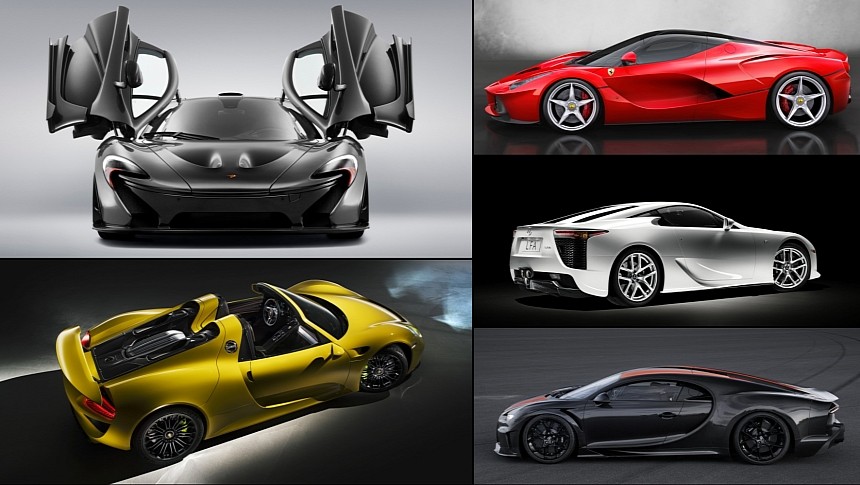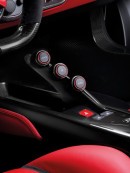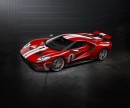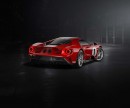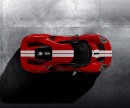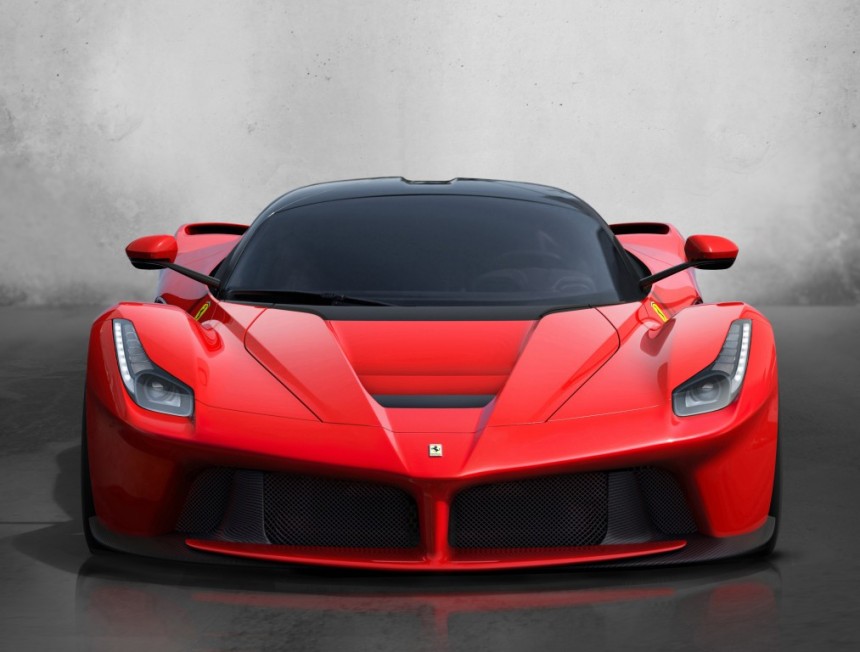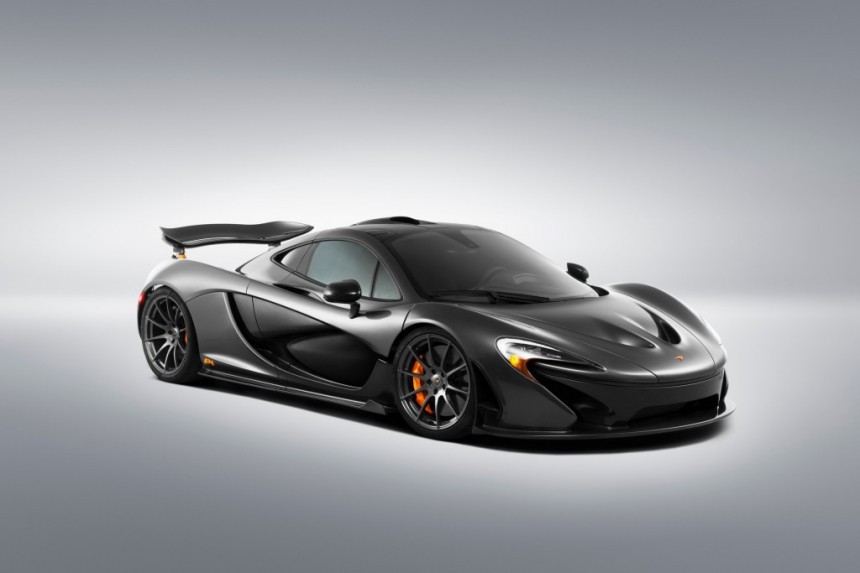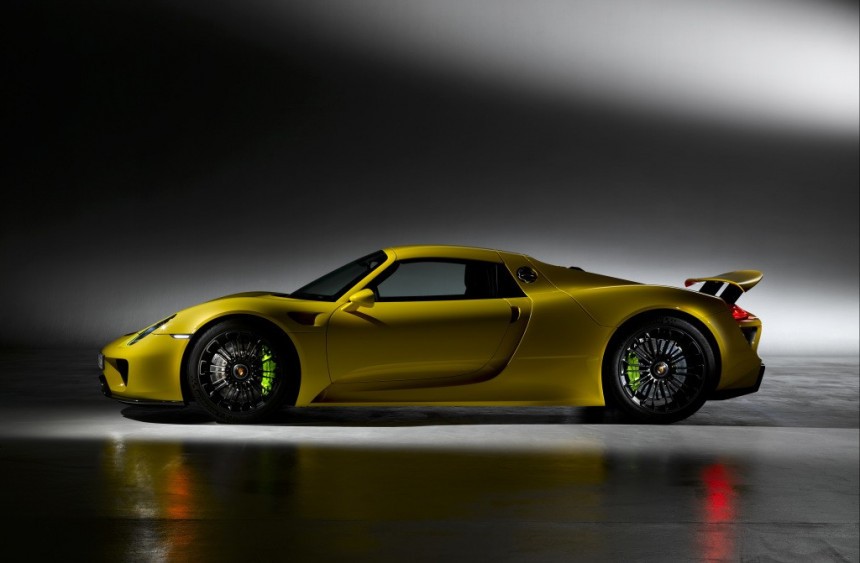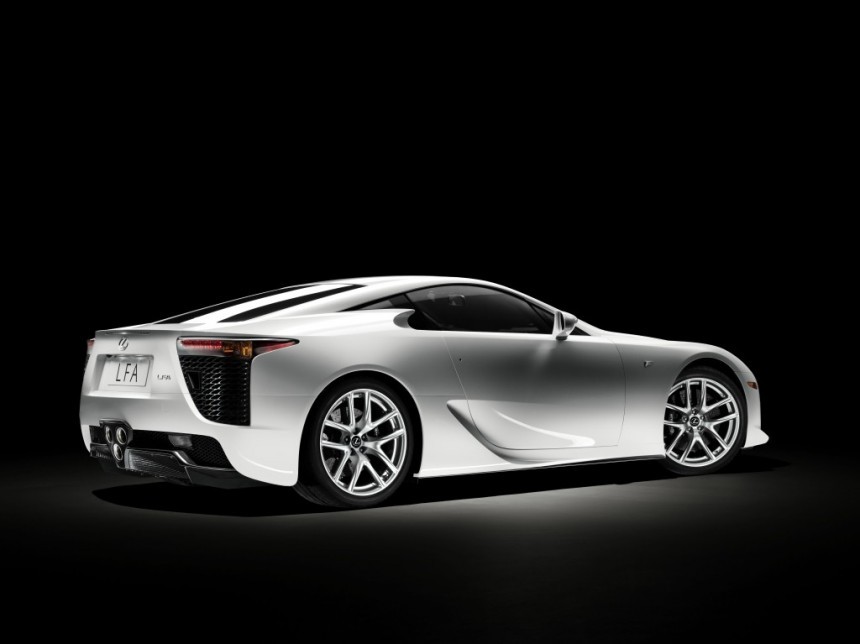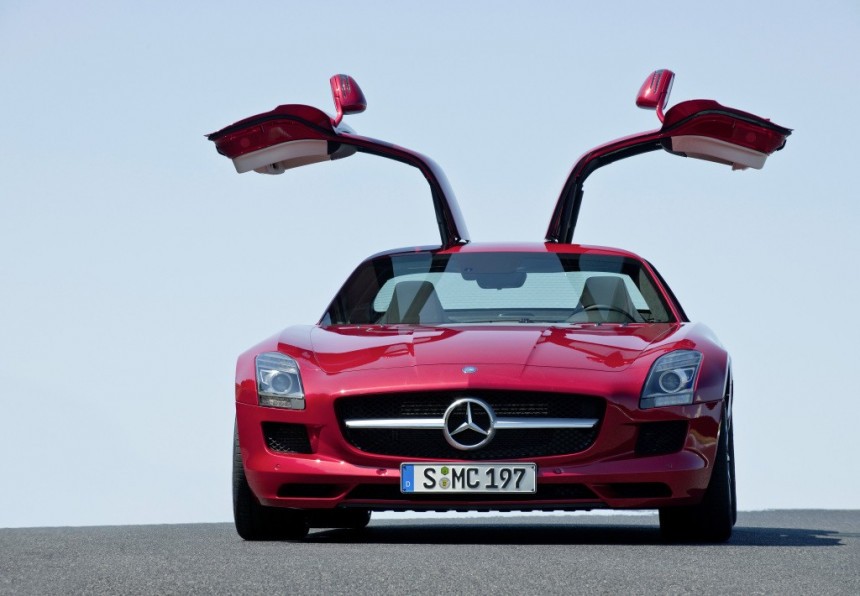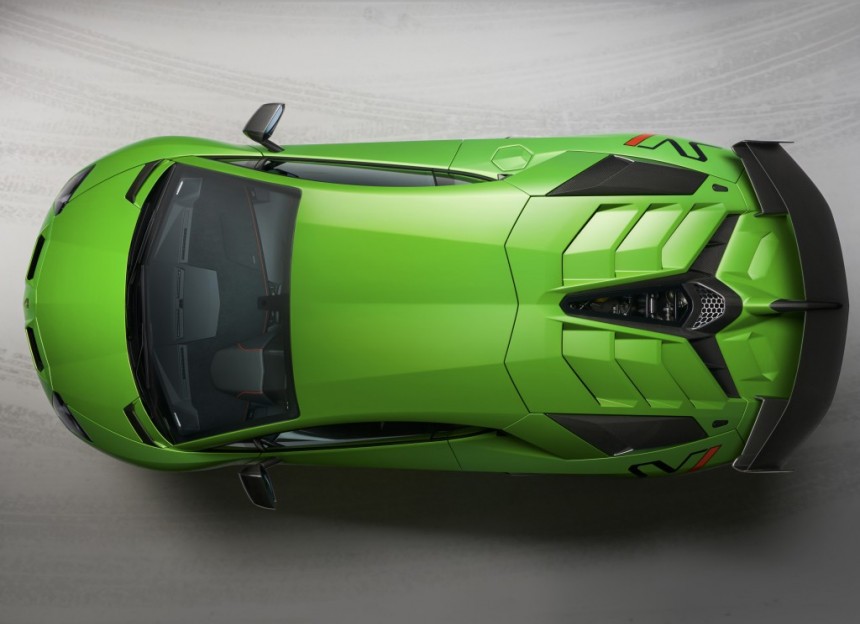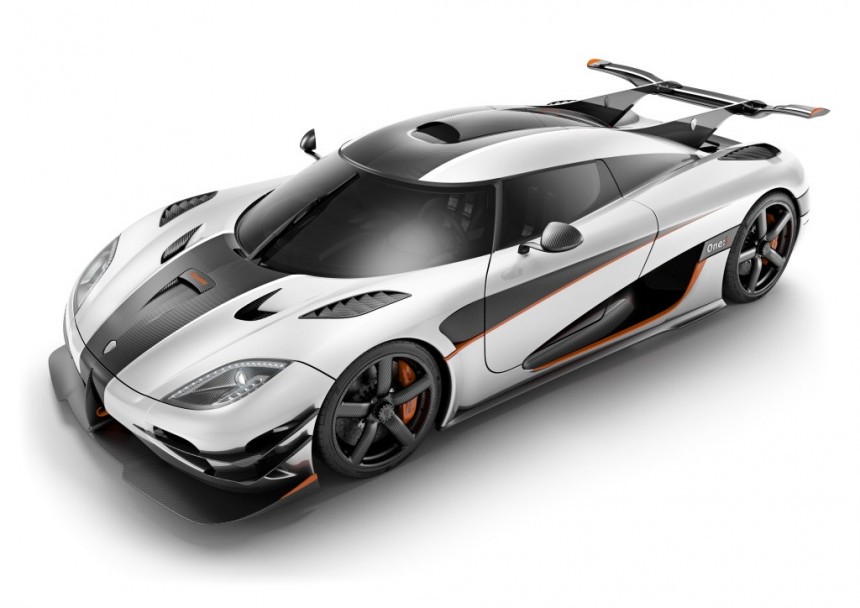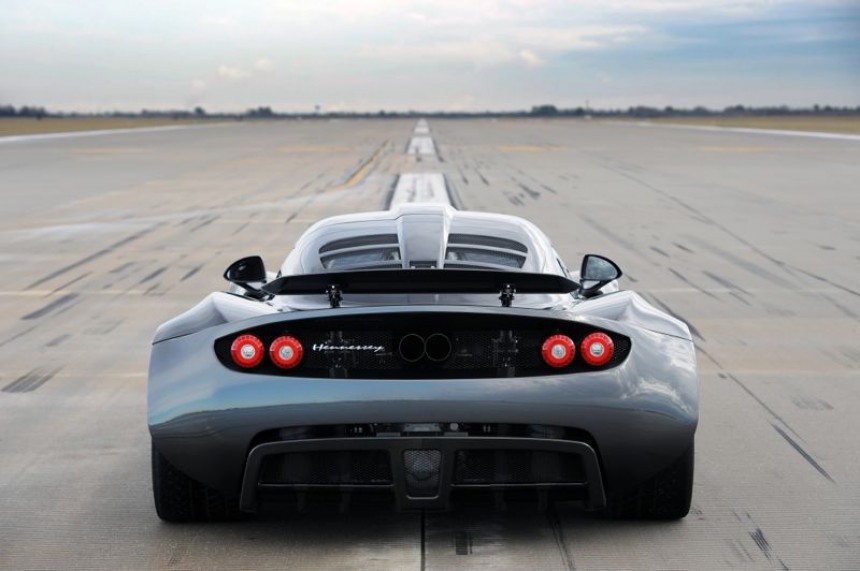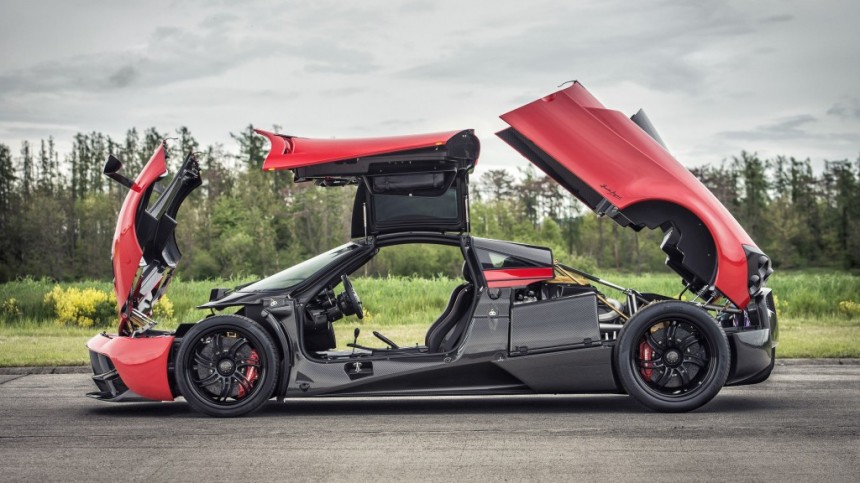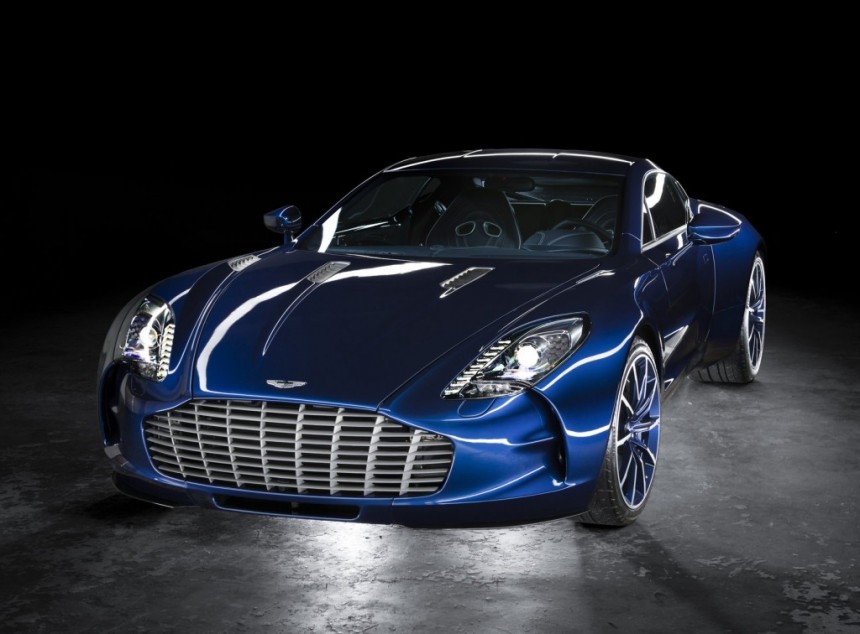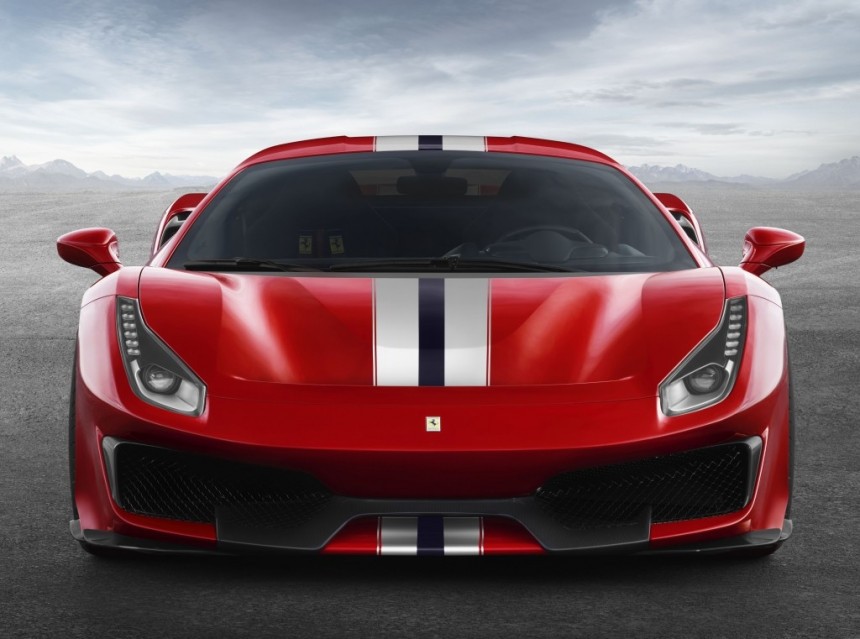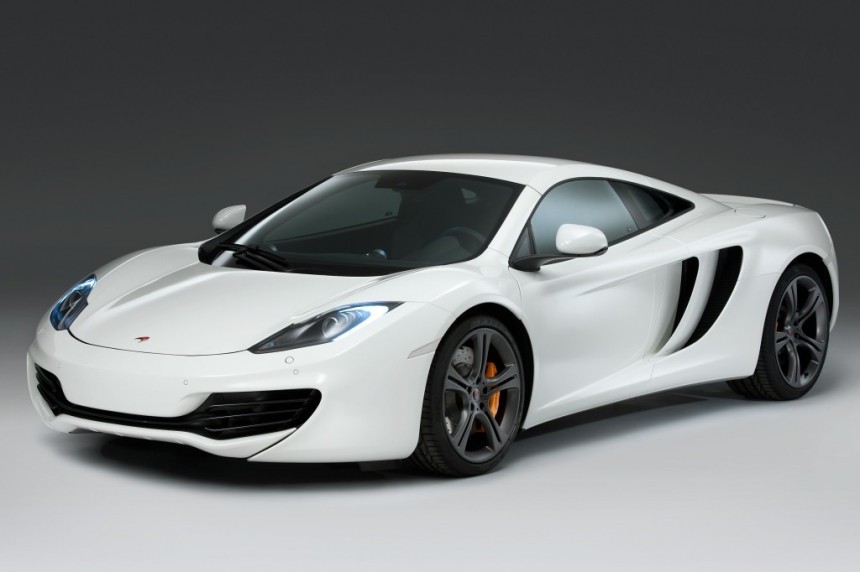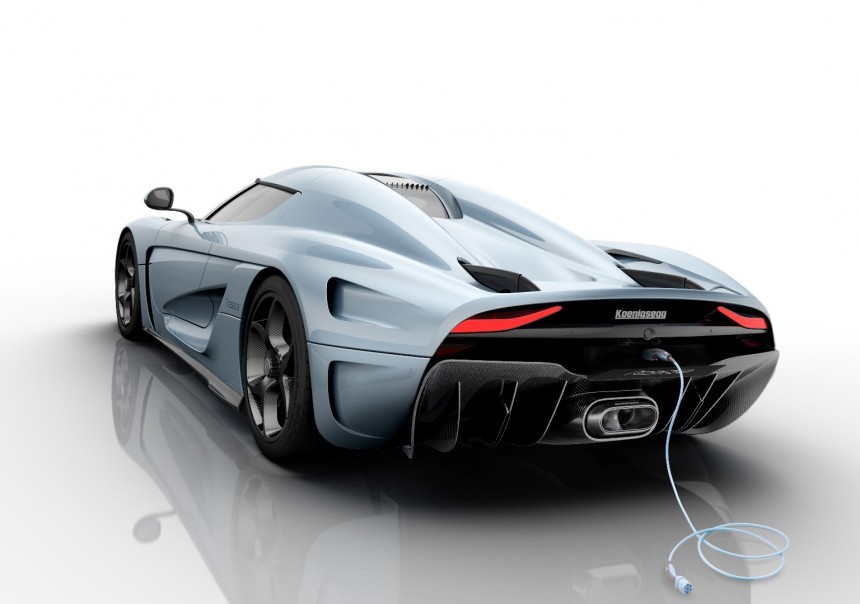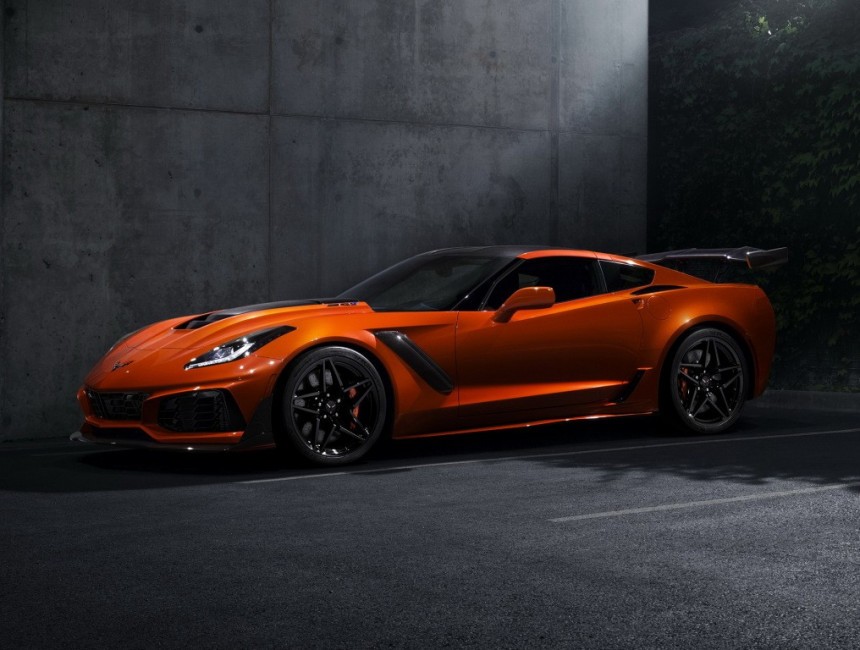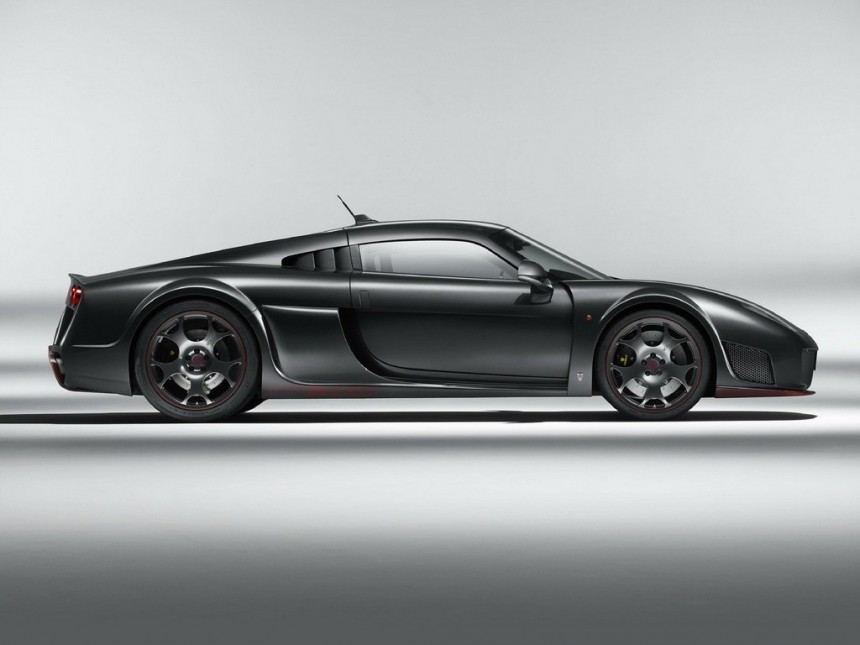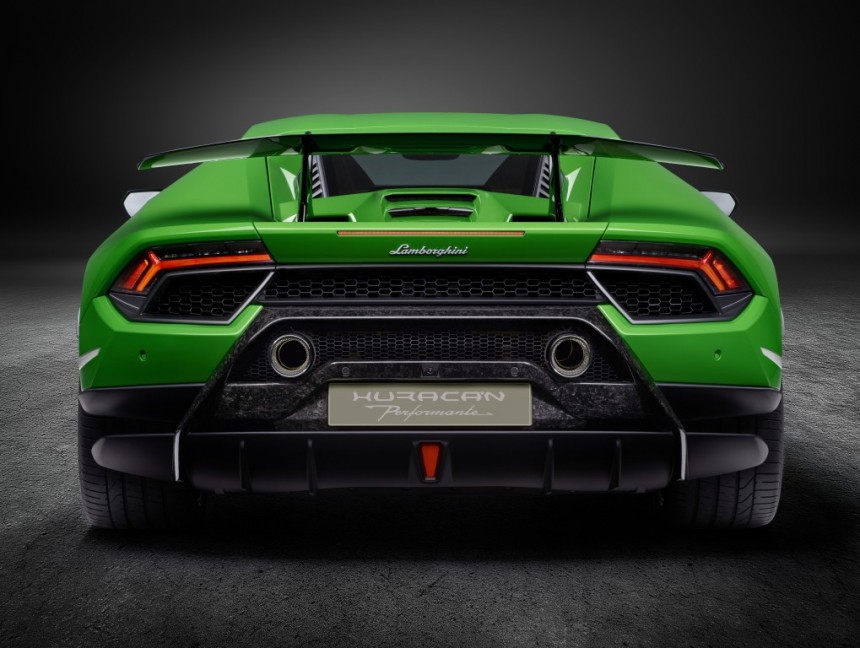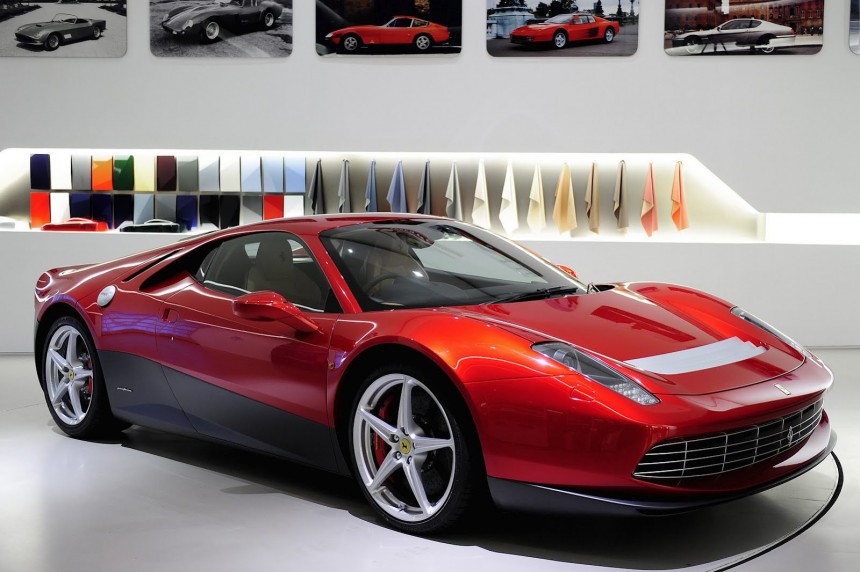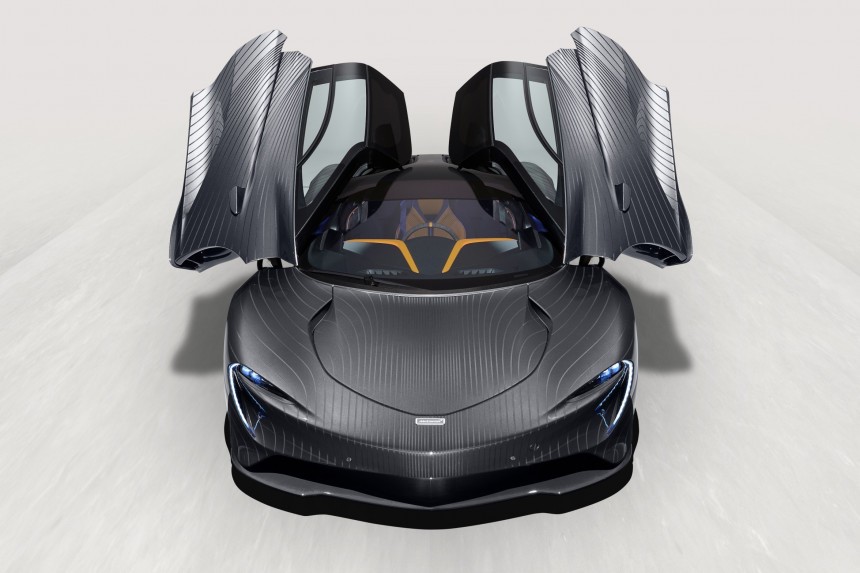Arguably the most desirable type of vehicle, the supercar can trace its roots back to the Lamborghini Miura. Although it wasn't the first production vehicle with a midship setup (French automaker Matra did it first with the Djet in 1962), the transverse-engined raging bull is a trailblazer for all the right reasons.
Not to be confused with the Australian Supercars Championship (which pits the Ford Mustang against the Chevrolet Camaro in 2023), supercars embraced Marcello Gandini's wedge design obsession in the 1970s. A term that was previously used by American motoring publications to describe straight-line thrillers, supercar doesn't necessarily mean a mid-engine layout.
The Aston Martin V8 Vantage from 1977 comes to mind with its 390-horsepower V8. By comparison, the 350-ci small block of the Corvette from that era packs 210 ponies at full chatter. Speaking of the Corvette, the C7-gen ZR1 (produced for model year 2019 only) was appropriately designated as one by General Motors.
Still the most powerful series-production 'Vette of all time, the seventh-generation ZR1 made our list of the best supercars of the 2010s. Care to guess what other supercars deserved a place on it? Let's kick it off, then!
A rather pompous name for a car that's not as fast as the SF90 XX Stradale at Pista di Fiorano, LaFerrari was a turning point for the Prancing Horse of Maranello. The brand's first hybrid incorporates a Formula 1-derived kinetic energy recovery system, which assists the naturally-aspirated V12 with short bursts of 120 kW (make that 163 metric ponies or 161 horsepower).
Connected to a dual-clutch transmission rather than the Enzo's automated manual, the LaFerrari still hasn't received a successor. The final example of the breed was finished in August 2018, and the long-awaited replacement for the F150 bears the F250 internal codename.
As opposed to the V8-powered SF90 series, the LaFerrari's hybrid-infused heir apparent makes twin-turbo V6 noises. More of a Le Mans endurance racer for the road than a limited-run supercar, the heavily anticipated F250 is certain to break the lap record at Fiorano.
Can you believe McLaren pulled the veils off the P1 in March 2013, the month when Baauer's Harlen Shake was all the rage? A most ambitious machine, the P1 uses a development of the carbon-fiber monocoque introduced by the 12C, the British automaker's first production car since the iconic F1 from the 1990s.
Although it flaunts a familiar twin-turbo V8, the P1 spruced things up over the 12C with the addition of an electric motor. An in-house development rather than an off-the-shelf unit, that is, an electric motor powered by a 4.7-kWh battery pack of the lithium-ion variety.
Rarer than the LaFerrari, the P1 isn't as powerful (903 horsepower versus 950 horsepower). Ferrari can't be bothered by Nurburgring lap times, but we do know that a 986-hp P1 LM converted for street use by Lanzante clocked a staggering 6:43 at the German circuit.
The 2010s marked the beginning of the hybrid supercar revolution. A very different animal from the V10-engined Carrera GT, the 918 Spyder bested the rear-wheel-drive McLaren P1 with one additional motor on the front axle, representing a tremendous advantage in terms of both acceleration and handling.
Even so, it wasn't the most powerful of the so-called Holy Trio. Produced in precisely 918 units, the plug-in hybrid supercar from Zuffenhausen cranks out a respectable 875 horsepower. On the other hand, its peak torque challenges that of heavy-duty turbo diesel trucks (944 pound-feet or 1,280 Nm versus 975 pound-feet or 1,322 Nm for the 2024 Chevrolet Silverado HD).
The 918 Spyder is one of the fastest series-production cars at the Green Hell, with racing driver Marc Lieb recording 6:57 back in 2013 on Michelin Pilot Sport Cup 2 tires. By comparison, the 992.1-generation 911 GT3 RS needed 6:44 on Michelin Pilot Sport Cup 2 Rs.
The first of four front-mid-engine supercars on this list, the LFA is a four-wheeled flex of sorts. How come? Let's put it this way: the LFA sold at $375,000 apiece, yet each car took roughly $750,000 to build.
Originally intended with an aluminum spaceframe, the LFA was redesigned with a carbon-fiber tub at a tremendous cost. All told, the program is believed to have cost Lexus an eye-watering $800 million. The original LS that made Lexus a household name? More than $1 billion.
64 examples of the 500-strong production run were finished in Nurburgring flavor, a go-faster spec that hiked up the LFA's price to $445,000. Gifted with the sonorous V10 of the LFA, which was co-developed with Yamaha, the Nurburgring package offers 10 more horsepower and snappier transmission response.
Arguably the most over-the-top entry on this list, the Chiron is best described in three words: passing the torch. The Veyron did its thing in the 2000s, with racing driver Pierre-Henri Raphanel hitting 434.211 kilometers per hour (269.806 miles per hour) in a derestricted Veyron Super Sport at the Ehra-Lessien facility in Germany.
The Chiron? 490.484 kilometers per hour (304.773 miles per hour) at said facility, although road-going examples of the Chiron Super Sport 300+ are limited to 440 kph (273 mph). At press time, it is the world's fastest production car.
Alternatively called hypercar, the Chiron may lose its crown in the near future. Both Hennessey and Koenigsegg promise more than 310 miles per hour (499 kilometers per hour) from the Venom F5 and Jesko Absolut, yet neither company has delivered on those claims. Yet…
2010 saw the rebranding of Brawn GP into Mercedes GP, marking the German automaker's return to Formula 1 as a constructor rather than an engine supplier. 2010 also saw the return of Michael Schumacher, a surprising homecoming. After all, the Red Baron couldn't say no to the one and only Ross Brawn.
Mercedes back as a constructer meant that Mercedes couldn't continue collaborating with McLaren for the SLR McLaren's replacement. With AMG's help, the Stuttgart-based automaker delivered one hell of a high-performance grand tourer in the form of the C197/R197 SLS AMG.
Offered between 2010 and 2014 for model year 2010 through 2015, the front-mid-engine supercar also spawned a high-performance version (Black Series) and an electric version (Electric Drive). The latter is the most powerful and rarest of the bunch, with Merc finishing only nine customer vehicles. The Electric Drive rocks four electric motors that belt out a combined 740 horsepower.
Lamborghini's history can be split into two parts: before and after the Volkswagen Group. The German automaker's Audi division purchased the Italian marque for an estimated $110 million in 1998, when Automobili Lamborghini already had two concepts on its table.
Both the Acosta and Canto were deemed a bit meh by Volkswagen Group big kahuna Ferdinand Piech, who tasked Luc Donckerwolke with designing something completely different as the replacement for the Diablo. The resulting Murcielago blurs the line between old and new, for it was the last time Lamborghini used the Giotto Bizzarrini-designed V12 we all know and love.
The subsequent Aventador signaled the bitter end of that fabulous engine, but looking at the bigger picture, it was for the best. Previously struggling to stay afloat, Automobili Lamborghini is so profitable nowadays that the Volkswagen Group allowed Lamborghini to develop an entirely new V12 for the plug-in hybrid Revuelto.
One:1 refers to this fellow's power-to-weight ratio, as in 1,360 metric ponies (1,341 mechanical ponies) for 1,360 kilograms (that would be 2,998 pounds). Koenigsegg advertised the One:1 as the world's first megacar, which is another way of saying one megawatt (1,360 metric horsepower) in a four-wheeled package.
A grand total of seven units were produced, including the working prototype from the 2014 Geneva Motor Show. A development of the Agera S, the One:1 also took inspiration from the CCXR. More specifically, its 5.0L twin-turbocharged V8 also runs on E85.
Weighing in at 197 kilograms (434 pounds), the force-fed lump is joined by a dual-clutch tranny. The One:1 isn't the fastest Agera out there, though. Said title goes to the Agera RS, which topped 458 kilometers per hour (285 miles per hour) in 2017 on a closed highway with factory driver Niklas Lilja in the driver's seat.
Coming from Texas, the Venom GT isn't entirely American. Similar to the first-gen Tesla Roadster, the Venom GT is underpinned by the bonded extruded aluminum chassis of the Lotus Elise. Of course, Hennessey modified it greatly in order to create this incredible car.
Under the rear deck lid, you'll find a twin-turbocharged V8 with quite a few similarities to the LS7 of the sixth-gen Corvette Z06 and fifth-gen Camaro Z/28. Said powerplant also incorporates a few elements from the LS9, which General Motors used in the Corvette ZR1 (638 horsepower and 604 pound-feet or 815 Nm).
Proven to 270 miles per hour (435 kilometers per hour) at the Kennedy Space Center's shuttle landing strip, the Venom GT was offered in coupe (seven delivered in total) and roadster (six) flavors. The Venom GT Spyder wouldn't have happened if Aerosmith frontman Steven Tyler hadn't approached John Hennessey with this proposal back in 2011. Not exactly surprising, he took delivery of the very first unit the following year.
Founded by a former Lamborghini employee, Pagani Automobili rolled out the incredible-sounding Zonda at the 1999 Geneva Motor Show. The Huayra took the Modenese automaker in a different direction with the adoption of a twin-turbo V12 supplied by AMG.
Even so, Pagani couldn't resist giving the Huayra R track-only special edition a naturally-aspirated V12. Arguably the ultimate expression of the Italian supercar, the Huayra R makes 838 horsepower as opposed to 730 for the standard Huayra and 829 horsepower for the Tricolore. Head honcho Horacio Pagani also used the Huayra to create a special edition (the Codalunga) inspired by the Porsche 917 (his favorite racecar of all time).
All five sold out before the public reveal, with prices starting at €7 million. The most expensive car of all time, however, is Mercedes-Benz 300 SLR Uhlenhaut Coupe chassis number 196.110-00008/55. The second of two examples completed was auctioned by the folks at RM Sotheby's in May 2022 for a ridiculous €135 million or $143 million at current exchange rates.
Built around a carbon-fiber monocoque rather than the VH bonded-aluminum platform, the One-77 was – back then – the fastest Aston Martin ever. 220 miles per hour (354 kilometers per hour) is remarkable, but then again, so is the Cosworth-tuned V12 hiding under the hood.
The Valkyrie is the Aston to have nowadays, an Adrian Newey-designed masterpiece that's all about downforce rather than top speed. If you insist, the Valkyrie Coupe is much obliged to surpass 220 miles per hour. After all, the Valkyrie Spider promises over 218 (350) with the polycarbonate roof panels in place. The Valhalla, meanwhile, is estimated at 217 (349).
Whereas the original was designed to celebrate the Dearborn-based automaker's centennial, the six-cylinder scion raced at the 24 Heures du Mans, winning its class in 2016.
I'm a V8 fan as big as the next person, but going V6 was necessary because of aero requirements. The final unit of 1,350 was completed in February 2023 by Multimatic in Canada rather than FoMoCo in the United States. Although unrelated to the GT, the Mustang GT3-inspired Mustang GTD will also be assembled by Multimatic.
Dating back to the F154 BB of the California T, said powerplant spelled the end for naturally-aspirated V8 midships adorned with the Cavallino Rampante. It's a bit of a shame that we've lost the high-revving F136, yet remember that Ferrari still makes naturally-aspirated V12 cars.
The 488 series was a step in the right direction, and so was the 296 series. With a whopping 654 horsepower from six cylinders and 3.0 liters, it's no wonder the F163 twin-turbo sixer in the 296 will be used by Ferrari's next halo car.
Think design, aural pleasure, all that jazz. Produced between 2011 and 2014, the Frank Stephenson-styled 12C laid the foundation for every single McLaren of the modern era (save for the Formula 1-inspired Solus GT track-only supercar).
McLaren used a Ferrari 360 Modena for the 12C's first-ever test mule, dubbed MV1. A little over 3,400 units were finished in total as opposed to precisely 17,653 examples of the 360 series.
The Regera is no usual plug-in hybrid, though, for it brings together a trio of electric motors with a twin-turbo V8 and direct drive. In addition to being lighter than a conventional tranny, direct drive also means less energy loss to the wheels.
At low speeds, the wheel-shaft electric motors do the heavy lifting. After 30 miles per hour (almost 50 kilometers per hour), a hydraulic coupling locks up, allowing the engine to do its thing. By design, the Regera will reach its electronically limited top speed of 251 miles per hour (404 kilometers per hour) at 8,250 revolutions per minute.
The Y-body platform was further improved for the C7, the very last of the front-engined Corvettes. The 2015 model year Z06 is more powerful than any version of the Huracan, and the ZR1 is almost on par with the Aventador SVJ LP 770-4.
Not only a straight-line slingshot, the ZR1 with the ZTK performance package smashed the second-gen Ford GT's lap record at Virginia International Raceway's Grand Course West layout. One year later, the McLaren Senna improved by over two seconds on the ZR1's 2:37.25 lap time.
The V8-powered supercar inherited the chassis of the M15, which sported a Ford Duratec V6 with a couple of turbochargers for good measure. The M600 upgraded to the Volvo B8444S, a 60-degree V8 developed by Yamaha.
One of the last analog supercars of the 21st century, the M600 takes no prisoners. No anti-lock brakes and no stability control make it all the more thrilling, although Noble did include switchable traction control and a knob that allows the driver to tailor the V8's power output.
The Raging Bull of Sant'Agata Bolognese finished the 20,000th example in April 2022, a matte-gray Super Trofeo Omologata purchased by a gentleman from Monaco. Unfortunately, the Huracan will be leaving us in 2024. With it, the odd-firing V10 of the Huracan and R8 will also be discontinued in favor of a twin-turbo V8.
Purportedly good for 10,000 revolutions per minute, the new engine is rumored to be a development of the 4.0-liter unit in the Urus, a Porsche-Audi design that's been taken to 657 horsepower. The Huracan's plug-in hybrid successor is believed to develop in excess of 800 ponies, most likely more than the 819 of the Ferrari 296 series.
Enter the SP12 EC, a Special Projects commission with 458 Italia underpinnings. Penned by Centro Stile in collaboration with Pininfarina, the 512 BB-inspired supercar was intended to sport a thumping great V12. Unfortunately, Ferrari couldn't do better than the Italia's 4.5-liter V8.
The one they call Slowhand dropped 4.7 million freedom eagles on the SP12 EC. Adjusted for inflation, it's more like $6.3 million nowadays. For reference, the 9,000-rpm 458 Italia retailed at $225,325 when it came out.
Stretching over 5,137 millimeters (202.2 inches) compared to 4,544 (178.9) for the non-hybrid supercar, the Speedtail is the fastest-ever McLaren entitled to wear a license plate. Woking's favorite son couldn't achieve 250.4 miles per hour (403 kilometers per hour) without pop-out side cameras instead of side mirrors.
This detail means the Speedtail doesn't meet federal motor vehicle safety standards in the United States of America, which is a huge market for supercars. McLaren, however, chose digital mirrors knowing that potential clients from the US of A would be able to drive the Speedtail on public roads thanks to the Show or Display rule.
The Aston Martin V8 Vantage from 1977 comes to mind with its 390-horsepower V8. By comparison, the 350-ci small block of the Corvette from that era packs 210 ponies at full chatter. Speaking of the Corvette, the C7-gen ZR1 (produced for model year 2019 only) was appropriately designated as one by General Motors.
Still the most powerful series-production 'Vette of all time, the seventh-generation ZR1 made our list of the best supercars of the 2010s. Care to guess what other supercars deserved a place on it? Let's kick it off, then!
Ferrari LaFerrari
Connected to a dual-clutch transmission rather than the Enzo's automated manual, the LaFerrari still hasn't received a successor. The final example of the breed was finished in August 2018, and the long-awaited replacement for the F150 bears the F250 internal codename.
As opposed to the V8-powered SF90 series, the LaFerrari's hybrid-infused heir apparent makes twin-turbo V6 noises. More of a Le Mans endurance racer for the road than a limited-run supercar, the heavily anticipated F250 is certain to break the lap record at Fiorano.
McLaren P1
Although it flaunts a familiar twin-turbo V8, the P1 spruced things up over the 12C with the addition of an electric motor. An in-house development rather than an off-the-shelf unit, that is, an electric motor powered by a 4.7-kWh battery pack of the lithium-ion variety.
Rarer than the LaFerrari, the P1 isn't as powerful (903 horsepower versus 950 horsepower). Ferrari can't be bothered by Nurburgring lap times, but we do know that a 986-hp P1 LM converted for street use by Lanzante clocked a staggering 6:43 at the German circuit.
Porsche 918 Spyder
Even so, it wasn't the most powerful of the so-called Holy Trio. Produced in precisely 918 units, the plug-in hybrid supercar from Zuffenhausen cranks out a respectable 875 horsepower. On the other hand, its peak torque challenges that of heavy-duty turbo diesel trucks (944 pound-feet or 1,280 Nm versus 975 pound-feet or 1,322 Nm for the 2024 Chevrolet Silverado HD).
The 918 Spyder is one of the fastest series-production cars at the Green Hell, with racing driver Marc Lieb recording 6:57 back in 2013 on Michelin Pilot Sport Cup 2 tires. By comparison, the 992.1-generation 911 GT3 RS needed 6:44 on Michelin Pilot Sport Cup 2 Rs.
Lexus LFA
Originally intended with an aluminum spaceframe, the LFA was redesigned with a carbon-fiber tub at a tremendous cost. All told, the program is believed to have cost Lexus an eye-watering $800 million. The original LS that made Lexus a household name? More than $1 billion.
64 examples of the 500-strong production run were finished in Nurburgring flavor, a go-faster spec that hiked up the LFA's price to $445,000. Gifted with the sonorous V10 of the LFA, which was co-developed with Yamaha, the Nurburgring package offers 10 more horsepower and snappier transmission response.
Bugatti Chiron
The Chiron? 490.484 kilometers per hour (304.773 miles per hour) at said facility, although road-going examples of the Chiron Super Sport 300+ are limited to 440 kph (273 mph). At press time, it is the world's fastest production car.
Alternatively called hypercar, the Chiron may lose its crown in the near future. Both Hennessey and Koenigsegg promise more than 310 miles per hour (499 kilometers per hour) from the Venom F5 and Jesko Absolut, yet neither company has delivered on those claims. Yet…
Mercedes-Benz SLS AMG
Mercedes back as a constructer meant that Mercedes couldn't continue collaborating with McLaren for the SLR McLaren's replacement. With AMG's help, the Stuttgart-based automaker delivered one hell of a high-performance grand tourer in the form of the C197/R197 SLS AMG.
Offered between 2010 and 2014 for model year 2010 through 2015, the front-mid-engine supercar also spawned a high-performance version (Black Series) and an electric version (Electric Drive). The latter is the most powerful and rarest of the bunch, with Merc finishing only nine customer vehicles. The Electric Drive rocks four electric motors that belt out a combined 740 horsepower.
Lamborghini Aventador
Both the Acosta and Canto were deemed a bit meh by Volkswagen Group big kahuna Ferdinand Piech, who tasked Luc Donckerwolke with designing something completely different as the replacement for the Diablo. The resulting Murcielago blurs the line between old and new, for it was the last time Lamborghini used the Giotto Bizzarrini-designed V12 we all know and love.
The subsequent Aventador signaled the bitter end of that fabulous engine, but looking at the bigger picture, it was for the best. Previously struggling to stay afloat, Automobili Lamborghini is so profitable nowadays that the Volkswagen Group allowed Lamborghini to develop an entirely new V12 for the plug-in hybrid Revuelto.
Koenigsegg One:1
A grand total of seven units were produced, including the working prototype from the 2014 Geneva Motor Show. A development of the Agera S, the One:1 also took inspiration from the CCXR. More specifically, its 5.0L twin-turbocharged V8 also runs on E85.
Weighing in at 197 kilograms (434 pounds), the force-fed lump is joined by a dual-clutch tranny. The One:1 isn't the fastest Agera out there, though. Said title goes to the Agera RS, which topped 458 kilometers per hour (285 miles per hour) in 2017 on a closed highway with factory driver Niklas Lilja in the driver's seat.
Hennessey Venom GT
Under the rear deck lid, you'll find a twin-turbocharged V8 with quite a few similarities to the LS7 of the sixth-gen Corvette Z06 and fifth-gen Camaro Z/28. Said powerplant also incorporates a few elements from the LS9, which General Motors used in the Corvette ZR1 (638 horsepower and 604 pound-feet or 815 Nm).
Proven to 270 miles per hour (435 kilometers per hour) at the Kennedy Space Center's shuttle landing strip, the Venom GT was offered in coupe (seven delivered in total) and roadster (six) flavors. The Venom GT Spyder wouldn't have happened if Aerosmith frontman Steven Tyler hadn't approached John Hennessey with this proposal back in 2011. Not exactly surprising, he took delivery of the very first unit the following year.
Pagani Huayra
Even so, Pagani couldn't resist giving the Huayra R track-only special edition a naturally-aspirated V12. Arguably the ultimate expression of the Italian supercar, the Huayra R makes 838 horsepower as opposed to 730 for the standard Huayra and 829 horsepower for the Tricolore. Head honcho Horacio Pagani also used the Huayra to create a special edition (the Codalunga) inspired by the Porsche 917 (his favorite racecar of all time).
All five sold out before the public reveal, with prices starting at €7 million. The most expensive car of all time, however, is Mercedes-Benz 300 SLR Uhlenhaut Coupe chassis number 196.110-00008/55. The second of two examples completed was auctioned by the folks at RM Sotheby's in May 2022 for a ridiculous €135 million or $143 million at current exchange rates.
Aston Martin One-77
First showcased in 2008, the One-77 started customer deliveries in 2011. As implied, a mere 77 examples were assembled at the British automaker's Gaydon production facility.Built around a carbon-fiber monocoque rather than the VH bonded-aluminum platform, the One-77 was – back then – the fastest Aston Martin ever. 220 miles per hour (354 kilometers per hour) is remarkable, but then again, so is the Cosworth-tuned V12 hiding under the hood.
The Valkyrie is the Aston to have nowadays, an Adrian Newey-designed masterpiece that's all about downforce rather than top speed. If you insist, the Valkyrie Coupe is much obliged to surpass 220 miles per hour. After all, the Valkyrie Spider promises over 218 (350) with the polycarbonate roof panels in place. The Valhalla, meanwhile, is estimated at 217 (349).
Ford GT
The second-generation Ford GT polarizes opinion. Switching from a V8 to a V6 was hugely unpopular, and it's easy to understand why if you have an ear for great-sounding powerplants. Be that as it may, the second gen is closer in character to the GT40 racing car from the 1960s.Whereas the original was designed to celebrate the Dearborn-based automaker's centennial, the six-cylinder scion raced at the 24 Heures du Mans, winning its class in 2016.
I'm a V8 fan as big as the next person, but going V6 was necessary because of aero requirements. The final unit of 1,350 was completed in February 2023 by Multimatic in Canada rather than FoMoCo in the United States. Although unrelated to the GT, the Mustang GT3-inspired Mustang GTD will also be assembled by Multimatic.
Ferrari 488
488 cubic centimeters (actually 487.75) times eight means 3.9 liters. The F154 CB in the 488 series is listed with 3,902 cubes to its name, a displacement shared with later versions of the twin-turbo V8, including the F154 CD of the Pista, F154 CG of the F8, and F154 FA of the SF90.Dating back to the F154 BB of the California T, said powerplant spelled the end for naturally-aspirated V8 midships adorned with the Cavallino Rampante. It's a bit of a shame that we've lost the high-revving F136, yet remember that Ferrari still makes naturally-aspirated V12 cars.
The 488 series was a step in the right direction, and so was the 296 series. With a whopping 654 horsepower from six cylinders and 3.0 liters, it's no wonder the F163 twin-turbo sixer in the 296 will be used by Ferrari's next halo car.
McLaren 12C
McLaren Cars, the company that gave us the F1 and SLR McLaren, was refashioned into McLaren Automotive in 2010 for the sole purpose of designing supercars that would make Ferrari and Lamborghini blush in awe. The technically brilliant 12C didn't quite manage it because Macca focused too much on the geeky stuff rather than the emotional side.Think design, aural pleasure, all that jazz. Produced between 2011 and 2014, the Frank Stephenson-styled 12C laid the foundation for every single McLaren of the modern era (save for the Formula 1-inspired Solus GT track-only supercar).
McLaren used a Ferrari 360 Modena for the 12C's first-ever test mule, dubbed MV1. A little over 3,400 units were finished in total as opposed to precisely 17,653 examples of the 360 series.
Koenigsegg Regera
After experiencing the relentless acceleration of a Tesla Model S P85+ that he purchased in 2013, founder Christian von Koenigsegg decided to replicate that feeling of instant power delivery in a Koenigsegg. Instead of going battery electric, the bossman opted for a plug-in setup.The Regera is no usual plug-in hybrid, though, for it brings together a trio of electric motors with a twin-turbo V8 and direct drive. In addition to being lighter than a conventional tranny, direct drive also means less energy loss to the wheels.
At low speeds, the wheel-shaft electric motors do the heavy lifting. After 30 miles per hour (almost 50 kilometers per hour), a hydraulic coupling locks up, allowing the engine to do its thing. By design, the Regera will reach its electronically limited top speed of 251 miles per hour (404 kilometers per hour) at 8,250 revolutions per minute.
C7 Corvette
The Corvette leveled up its handling chops with the hydroformed box frame and rear-mounted transaxle of the C5. General Motors then kicked into overdrive with the C6, which broke with tradition by calling upon a blower for the ZR1.The Y-body platform was further improved for the C7, the very last of the front-engined Corvettes. The 2015 model year Z06 is more powerful than any version of the Huracan, and the ZR1 is almost on par with the Aventador SVJ LP 770-4.
Not only a straight-line slingshot, the ZR1 with the ZTK performance package smashed the second-gen Ford GT's lap record at Virginia International Raceway's Grand Course West layout. One year later, the McLaren Senna improved by over two seconds on the ZR1's 2:37.25 lap time.
Noble M600
Noble is one of those boutique supercar manufacturers that appeals to a certain type of individual. Brought to prominence in October 2002 after Jeremy Clarkson tested an M12 on Top Gear, the Leicester-based automaker got serious with the hideously underrated M600.The V8-powered supercar inherited the chassis of the M15, which sported a Ford Duratec V6 with a couple of turbochargers for good measure. The M600 upgraded to the Volvo B8444S, a 60-degree V8 developed by Yamaha.
One of the last analog supercars of the 21st century, the M600 takes no prisoners. No anti-lock brakes and no stability control make it all the more thrilling, although Noble did include switchable traction control and a knob that allows the driver to tailor the V8's power output.
Lamborghini Huracan
The Gallardo brought new customers to the brand. Lamborghini's pre-Urus golden goose totaled 14,022 units, and Lamborghini didn't change the winning recipe for the Huracan. Put simply, the Italian automaker softened the rough edges (think dual-clutch transmission versus the former automated manual) and squeezed out more power and torque out of the V10.The Raging Bull of Sant'Agata Bolognese finished the 20,000th example in April 2022, a matte-gray Super Trofeo Omologata purchased by a gentleman from Monaco. Unfortunately, the Huracan will be leaving us in 2024. With it, the odd-firing V10 of the Huracan and R8 will also be discontinued in favor of a twin-turbo V8.
Purportedly good for 10,000 revolutions per minute, the new engine is rumored to be a development of the 4.0-liter unit in the Urus, a Porsche-Audi design that's been taken to 657 horsepower. The Huracan's plug-in hybrid successor is believed to develop in excess of 800 ponies, most likely more than the 819 of the Ferrari 296 series.
Ferrari SP12 EC
Ferrari is known for using set criteria to decide who can buy the brand's most special models. Some of the richest people out there haven't been offered the opportunity of getting a LaFerrari, yet Eric Clapton had a one-off supercar designed for him by the Prancing Horse of Maranello.Enter the SP12 EC, a Special Projects commission with 458 Italia underpinnings. Penned by Centro Stile in collaboration with Pininfarina, the 512 BB-inspired supercar was intended to sport a thumping great V12. Unfortunately, Ferrari couldn't do better than the Italia's 4.5-liter V8.
The one they call Slowhand dropped 4.7 million freedom eagles on the SP12 EC. Adjusted for inflation, it's more like $6.3 million nowadays. For reference, the 9,000-rpm 458 Italia retailed at $225,325 when it came out.
McLaren Speedtail
A follow-up to the F1, which still holds the title of the fastest naturally-aspirated production car in the world, the Speedtail is marketed by McLaren as a three-seat hyper GT. In truth, it's a heavily reworked 720S with a hybrid twist.Stretching over 5,137 millimeters (202.2 inches) compared to 4,544 (178.9) for the non-hybrid supercar, the Speedtail is the fastest-ever McLaren entitled to wear a license plate. Woking's favorite son couldn't achieve 250.4 miles per hour (403 kilometers per hour) without pop-out side cameras instead of side mirrors.
This detail means the Speedtail doesn't meet federal motor vehicle safety standards in the United States of America, which is a huge market for supercars. McLaren, however, chose digital mirrors knowing that potential clients from the US of A would be able to drive the Speedtail on public roads thanks to the Show or Display rule.
